February 21, 2017 | life
Pumping Iron is a 1977 documentary about bodybuilding, or rather about Arnold Schwarzenegger winning his sixth Mr. Olympia title. At the time, the documentary boosted Schwarzenegger’s image. I find that fascinating, as I was rather repulsed when I recently watched it. Albeit not by the insight into the world of bodybuilding, but how openly Schwarzenegger talks, even brags about how he manipulates competitors.
Take a look at Schwarzenegger having breakfast with Lou Ferrigno and his parents. Lou’s father was also his trainer.
Schwarzenegger also explicitly says that he’d give Franco Columbu, a competitor he was friends with, wrong advice to have an advantage. Call me naive, but I think these aren’t very good traits, for nobody.
In order not to be vulnerable to any kind of negative impact himself, Schwarzenegger basically shut down his emotions, he explains. To the point that when his father died two months before a competition, Schwarzenegger wasn’t affected by it. Overall, Schwarzenegger’s behavior might be a perfect example of toxic masculinity: Be dominant, be aggressive to win at whatever cost, don’t show feelings.
Schwarzenegger says that he sees these methods as “tools that are available, so you might as well use them”. I’d argue that whoever sees targeted attacks on an opponent’s psyche as “just another tool” doesn’t compete in bodybuilding, but in ruthlessness.
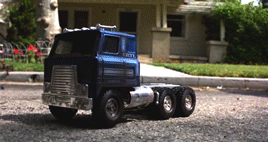
I know there’s smack talk in sports, but that’s a different thing. With yelling and some insult, while not being very classy, there’s a clear understanding of rivalry and what you’re competing to accomplish. Actively branching out and undermining your competitor’s psyche instead is pretty close to plain old sabotage. Mmmh, sweet success! And I thought being a good winner was a plain and simple concept, even easier than being a good loser.
But come on now, this is just me, unfairly judging something that happened 40 years ago with today’s morality standards, right? Well, Schwarzenegger’s behavior mostly seems to be praised for breaking new ground in “psychological warfare”, instead of being identified as what it is: manipulative and shallow.
I am not against being good at something, I am not at all against fair competition. Ferrigno did in fact win the title the following year and I’m not mourning his loss against Schwarzenegger. This 40-year old documentary simply shows a great example of someone who puts success above all else. We all know where this led Schwarzenegger: Career in acting and politics, belonging to the highest circles of US society. Realizing that the toll this took is a lack of humanity towards others as well as himself, casts this success in a very different light. With all of this out there and Schwarzenegger even bragging about his methods, without being criticized for it, one is hard-pressed to defend the mechanisms by which society awards approval. Also: Yay documentaries!
Pumping Iron is currently on Netflix.
December 29, 2015 | photography
So, in my last post I wrote about photography in general, and specifically about what helped me along the very first steps. In this one, I want to share the considerations and decisions that led to me going for the Olympus OM-D E-M10 (can you get all the hyphens right?), a mirrorless camera. Yes, just before 2015 runs out. Since I try and do sustainable blogging though, the broad strokes should stay relevant until the camera landscape changes dramatically.
I’m gonna try and give a quick and reasonably simplified overview of the current landscape in cameras first, how they differ, then describe what I find important interacting with a camera, how I almost setteld for a used DSLR, but then opted for a part of the mirrorless future. At the end I can’t help it and give a few tips on using the E-M10.
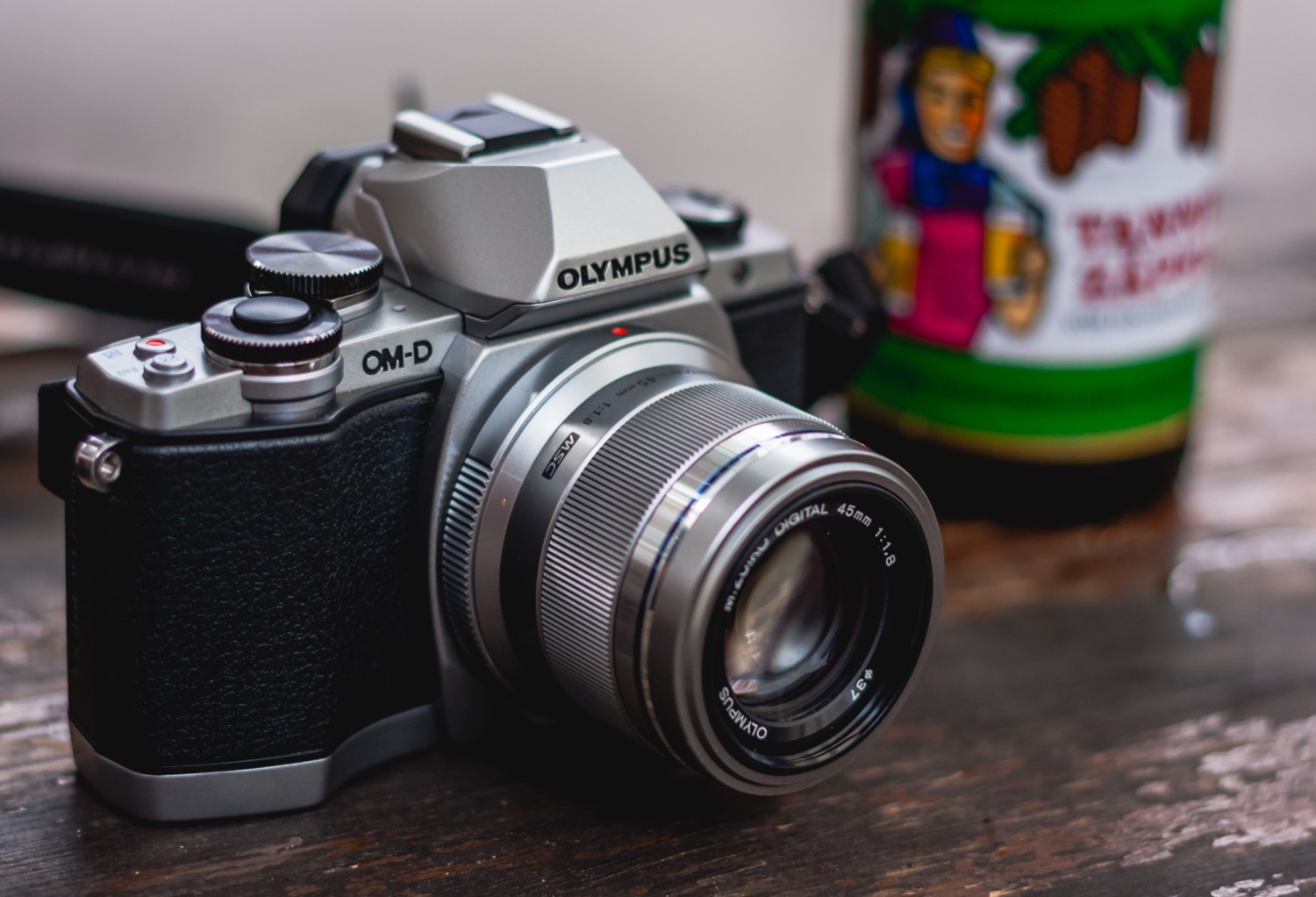
Olympus E-M10, with the Olympus 45mm f1.8 lens – and randomly placed former-hipster-now-mainstream beer
Kinds of Cameras
A little primer on the current field of products: There are DSLRs, which have an optical viewfinder, and because of that (I think), a mirror and a prism. This makes them big and bulky, and kinda heavy. But DSLRs are what professionals still swear by.
DSLRs are the ones with the mirror, so another kind of camera is called mirrorless, of course. This by itself has all the effects on how they’re built and what kind of properties they have. In short: They can be smaller and lighter than a DSLR, but they cannot have an optical viewfinder, and most of them have worse autofocus systems. But technology advances, and mirrorless bodies catch up quickly. They have electronic viewfinders (EVFs) that only get better with time. Anyway, DSLR vs mirrorless is the kind of discussion with sometimes religious undertones in the camera geek community right now.
The Wikipedia definition also throws an “interchangeable lens” property in there, and that distinguishes it from the next kind of camera. Before we get to that, I have to say that there’s not one mirrorless “standard”, since there are a few manufacturers doing their own thing. This isn’t the biggest difference between them, but the lens mount is ultimately the reason for the incompatibility of those systems. So by picking a specific manufacturer, you decide on which range of lenses you want to be able to chose from (just as with DSLRs between Nikon and Canon). There is the Micro Four Thirds system (or MFT, or M43, or µFT) championed by Panasonic and Olympus; there are Fuji’s mirrorless cameras (X-mount lenses), and there’s Sony’s ɑ-series (E-mount lenses).
Anyway, the next kind of camera is, of course, a compact or point-and-shoot camera. These are “mirrorless” as well, but have a fixed lens. While you’re just getting ready to be snobby and disregard these cameras (I certainly would), let me tell you that “compact” – actual surprise! – doesn’t necessarily mean “crappy”. To pick a popular current example: The Fuji X100 models are well-reviewed, loved as a fun camera by seasoned photographers, have a large sensor (more on that later) – and cost over 1000€/$, if that convinces you.
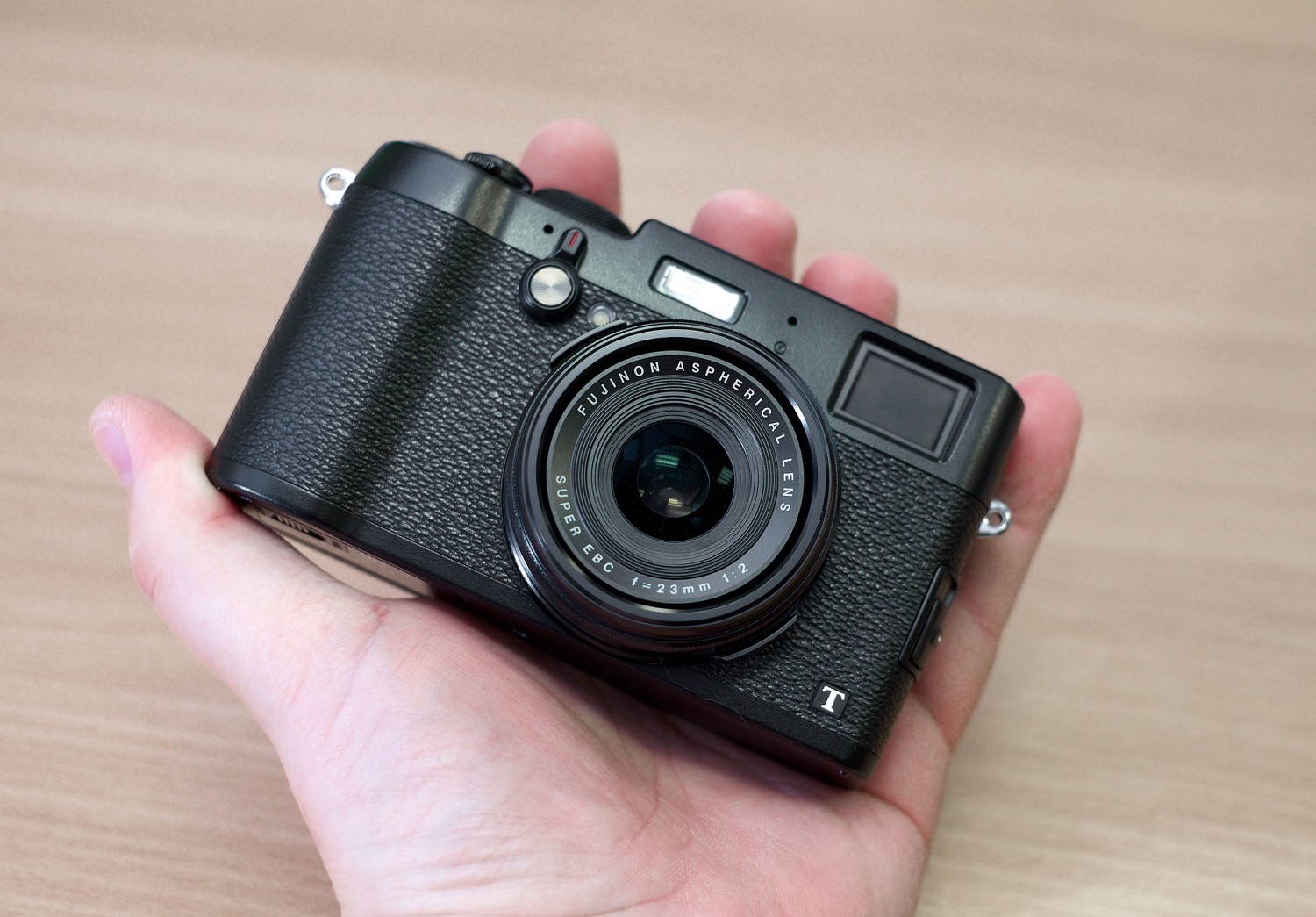
Fuji X100T – photo by Kārlis Dambrāns, used under CC-BY
Kinds of Sensors
When you’re talking cameras and lenses, you almost always are also talking sensor sizes, directly or indirectly. So, why does it matter?
The sensor of a digital camera is what film is in a film camera. And sensors come in different sizes. 35mm film is referred to as “full frame” (“Vollformat”, or perplexingly, “Kleinbild” in German, which translates to “small picture”). High-end DSLRs and some Sony mirrorless cameras have full frame sensors. Everything smaller than full frame is also referred to as a “crop sensor”. A very widespread sensor size is APS-C. Fuji and Sony use APS-C for some of their mirrorless cameras, and it’s also used in most consumer/prosumer-DSLRs. Relevant to my angle here is also the even smaller four thirds size used in the MFT systems mentioned above. Here, the crop factor is 2x, by the way. So if a lens is a 25mm, it has the properties of a 50mm lens on a full frame (35mm – confused yet?) sensor. People talk about 50mm being the “35mm equivalent” of that lens.
These cover the most relevant I think. And just if you were wondering (I was), there’s also something bigger, medium format. You like graphics? Here’s a graphic:
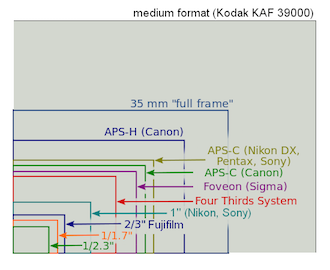
Sensor Sizes by MarcusGR, used under CC BY-SA
The bigger the sensor, the more information it can capture (d’uh). But there are two different ways to go about that: A sensor bigger than another can either be filled with more pixels, or with the same number of, but bigger pixels. More pixels allow for more detail (a.k.a. resolution), bigger pixels allow for more light to be caught (good low light performance, meaning less noise, therefore higher ISO allowing for shorter exposure possible). Those pixels, of course, are the megapixels everyone was talking about a few years ago.
Mix and Match
While there are differences in picture quality, any modern camera’s is sufficient for almost any purpose (If you believe people who know way more about this than me). That makes other factors more important: size and weight, number of dials, lens selection, kind of viewfinder, touchscreen, accentuating screen, Wifi?
Do you want to tap on a touchscreen to focus and take the picture? Then you don’t need an EVF. Do you “just” want to take nicer pictures than your phone allows for? Then you don’t necessarily need any fancy dials and function buttons and probably want the body to be as slim as possible. Do you want nice jpegs out of camera (no processing of the RAW in Lightroom)? People love the Fujis for that. If you just want want want a full frame sensor, you are either looking at a pro DSLR or the more expensive Sony cameras.
Here’s an example: The Olympus E-PL7 and the E-M10 are almost identical looking at the specs. The PL has one manual control dial instead of two, some buttons, a little extra grip and the EVF, but comes with a screen that folds down 180 degrees (sick selfie capability!). These two cameras will take the exact identical picture, though. It’s literally “only” the described differences in the body. Here’s a side by side view, and here is the E-PL7 in all its glory:
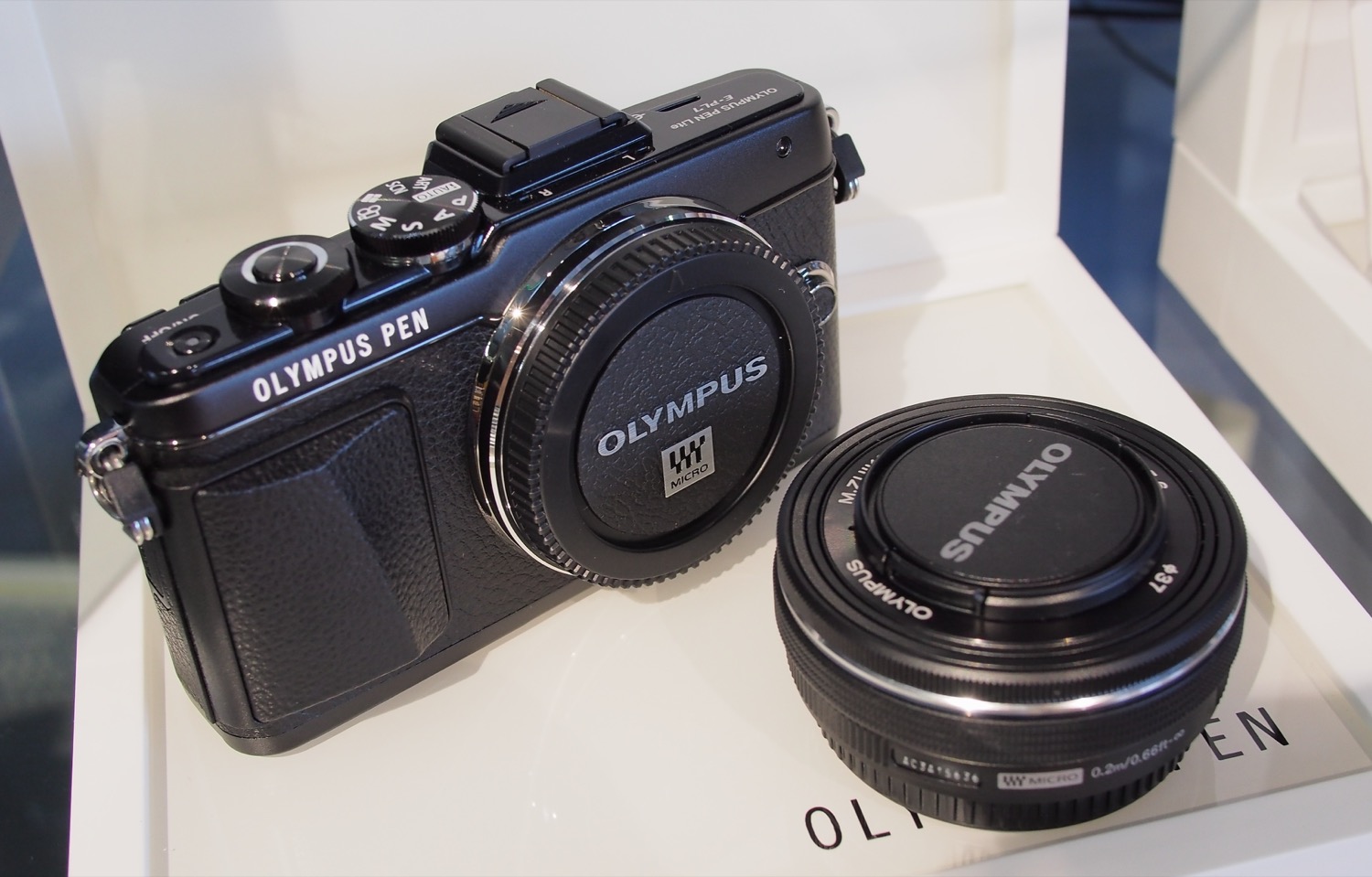
Olympus E-PL7 – photo by PetarM, used under CC-BY-SA
Choosing the E-M10
What helped me figure out that I wanted an E-M10 probably was handling my friend’s 40D. Not that I didn’t like it, actually the opposite: I loved it, especially that it felt like an analog tool, almost like a hammer (yeah, with dials, but still).
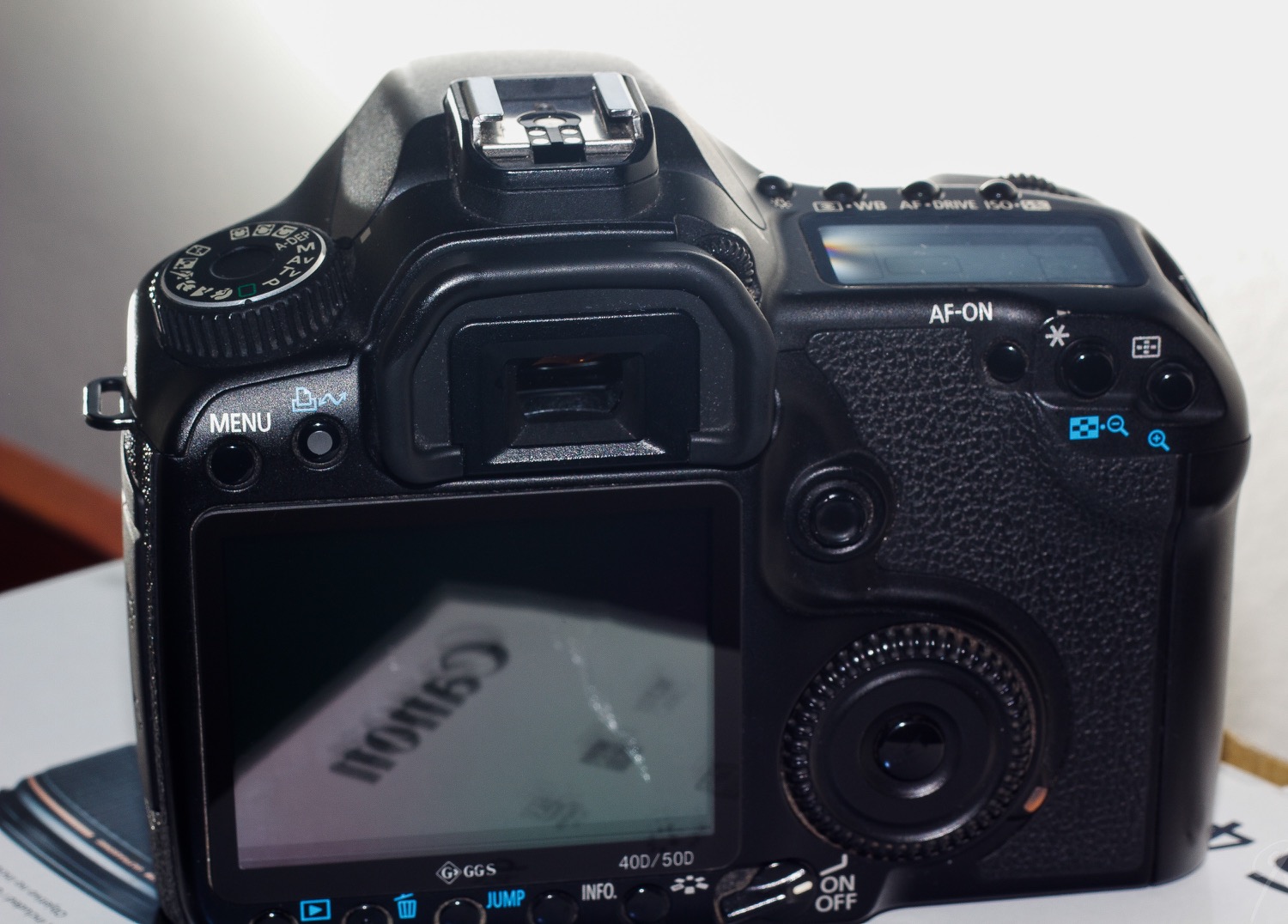
Canon 40D – photo by cubmundo, used under CC-BY-SA
I almost settled for a used 60D, which would’ve cost around 400€ and has some nice improvements over the 40D: More resolution without worse low light performance, more focus points, SD instead of CF cards. That sounded nice to me.
Then, another friend told me she wouldn’t recommend anybody without an investment in Canon or Nikon lenses to get in the DSLR market today. With mirrorless, picture quality is well beyond “good enough”, and there’s a big and affordable lens collection. I remembered Shawn Blanc’s E-PL5 review from one of the times when I was wondering if a “proper” camera would be something for me. Reading his review of the E-M10 then gave me an idea of what it offered that a slimmer camera like an E-PL could leave me wanting.
Anyway, all the advantages of mirrorless cameras kinda came back to me. If only there was one that also gave me what I loved about the 40D! Well, I had the opportunity to fool around with an E-M10 for a few days. By the way: It is the “smallest” in Olympus’ OM-D line, after the E-M5 and E-M1.
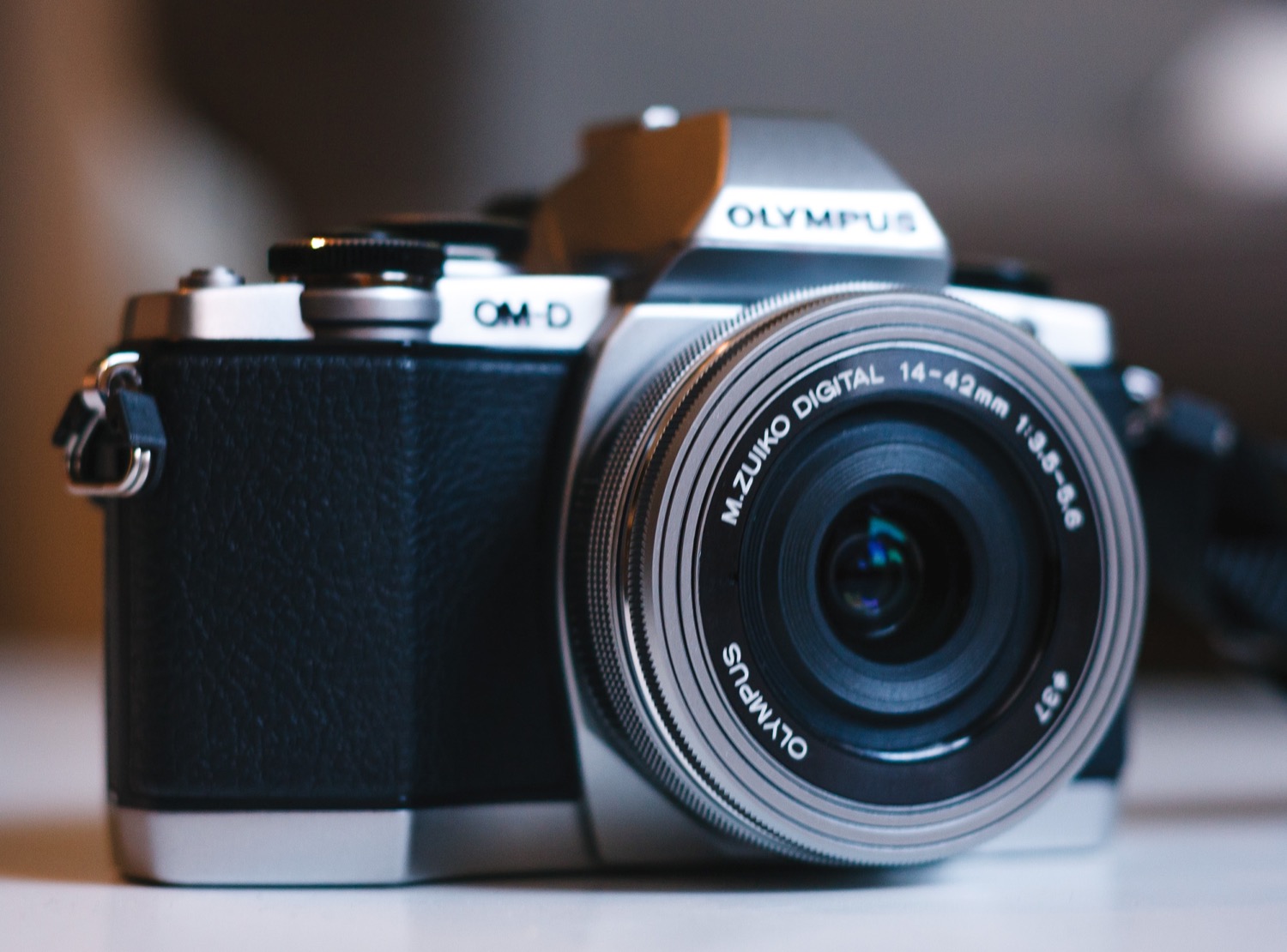
Olympus E-M10, with the Olympus 14-24mm kit lens – compact, but I wanted to go with prime lenses instead of zooms in the beginning
Electronic Viewfinder
What had turned me off the whole mirrorless thing before was the concept of an EVF. I had tried some at a big box reseller, and found them absolutely appalling. Probably very brigh, neon-lit surroundings and misconfiguration were to blame, because I didn’t hate the E-M10’s when I first tried it in real world conditions. I also wasn’t blown away, but it only got better with time.
The lag is not a problem for me at all. The resolution could be better I guess, but it is alright. And then, there are all the advantages that come with it being digital: Different grids to choose from, exposure correction affecting what you see, and looking at pictures you’ve taken or even the menu in the EVF as well – without taking the camera away from your eye. Very handy sometimes.
Dials
I had fallen in love with the big manual control dial on the 40D’s back. I used it for exposure compensation as well as scrolling through pictures, and knew that I didn’t want to miss this kind of control in my own camera. And there needed to be two of these, another one for adjusting the aperture or shutter speed, depending on the mode I’m shooting in.
All of this, I found in the E-M10 as well. As mentioned, it has two dials. In combination with a function button, these also allow for easy changing of the ISO and white balance without digging into a menu.
AF Point Selection
Another thing that I liked about the 40D was the little knob-thingy above the control dial for selecting the focus point. It only has 9 of them, so with one push in the right direction, the right focus point was selected.
The E-M10 has 81 focus points. Guess what doesn’t work with 81 focus points: Pushing once to select the right one. So you have to use the 4-way dial on the camera’s back, which for me is the weakest spot in day to day use. Pressing the dial ten or twelve times to get to the right point for the specific shot just isn’t fun. But it is possible without taking the camera from your eye, so it’s acceptable for me. The E-M10 II (released in August this year) goes at this with a touchscreen that acts as a trackpad (“AF targeting pad” when you hold the camera up. I don’t know how well that works, but the solution probably is somewhere along those lines. (I guess this is where the focus-and-recompose photographers cheer.)
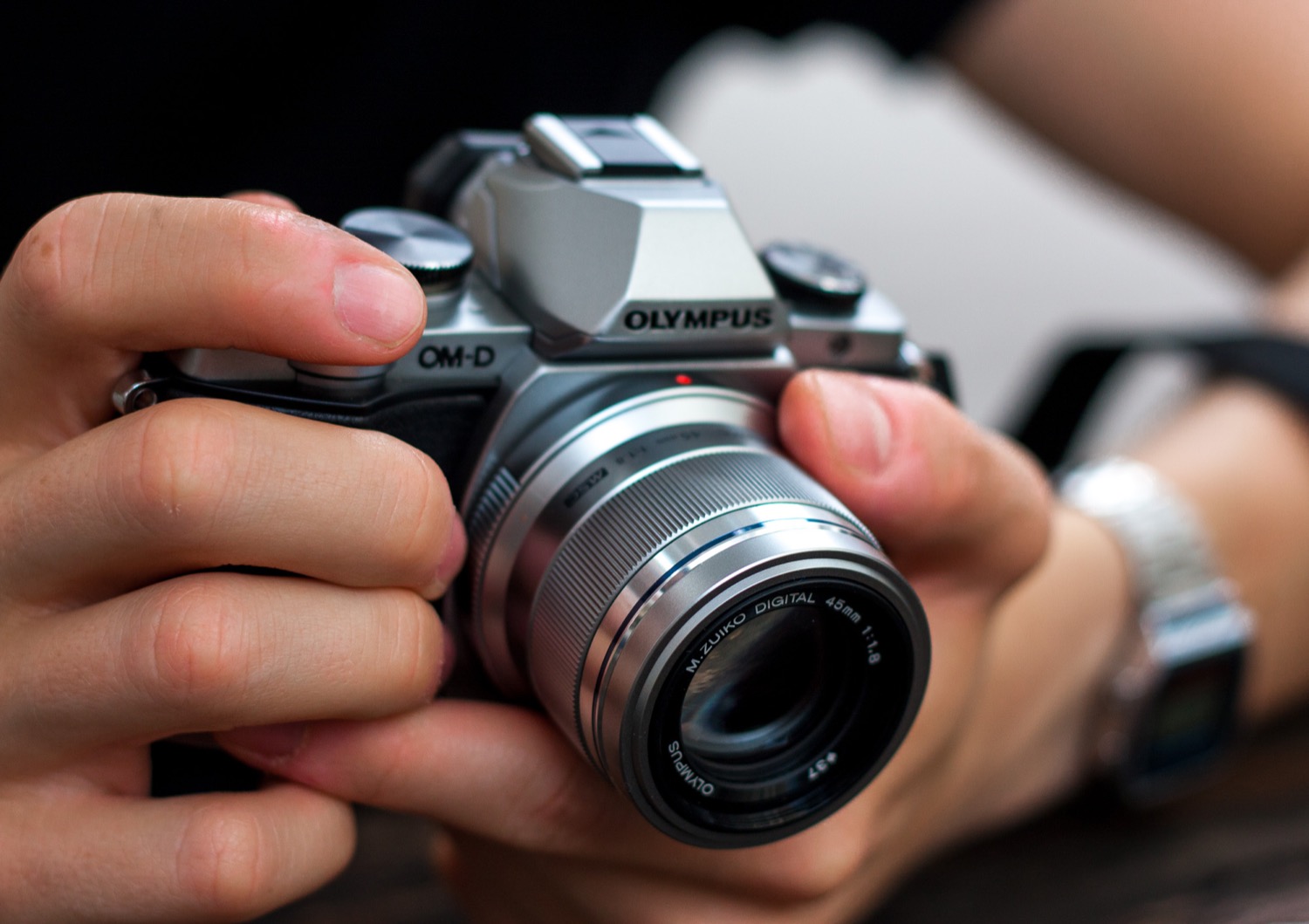
Olympus E-M10, with the Olympus 45mm f1.8 lens – photo by Silvan Dähn
Handling the E-M10
Because I’m overall endorsing the E-M10 here, I feel that I have to express a warning: The Olympus menus are a mess. They clearly stand in the way of the camera’s potential. A lot of stuff is possible with custom button and dial configurations and modes and settings etc., but it takes dedication to get there. Just a warning. These help: Here’s a guide in German, here’s a shorter overview, and this DPreview thing about the E-M5 also mostly applies to the E-M10.
Another gripe: although Auto ISO is a nice feature, it is badly implemented: The camera is way too conservative with the ISO and doesn’t let you take full advantage of the excellent IBIS (in-body image stabilization). DPreview has a workaround that makes it a little better. I still mostly set the ISO manually. This would be the second most annoying thing about the E-M10 for me, after the AF selection. But it’s a pure software thing, which makes it more incomprehensible that Olympus doesn’t just fix it with an update.
Enough with the negative though. There’s talk about the short battery life with mirrorless cameras. While you are not gonna get close to a DSLR’s, I found very long shooting sessions with several hundred (ca. 500 with one charge? I don’t remember for sure, but up there somewhere) exposures were no problem at all, meaning it’s not close to annoyingly short for me. With the E-M10, the key is to use the EVF and have the main screen not act as a viewfinder and suck battery when you don’t even need it. This way, waiting for a shot, you can dial the settings in, and the camera just lights up a display instead of transmitting the sensor image to the screen as well.
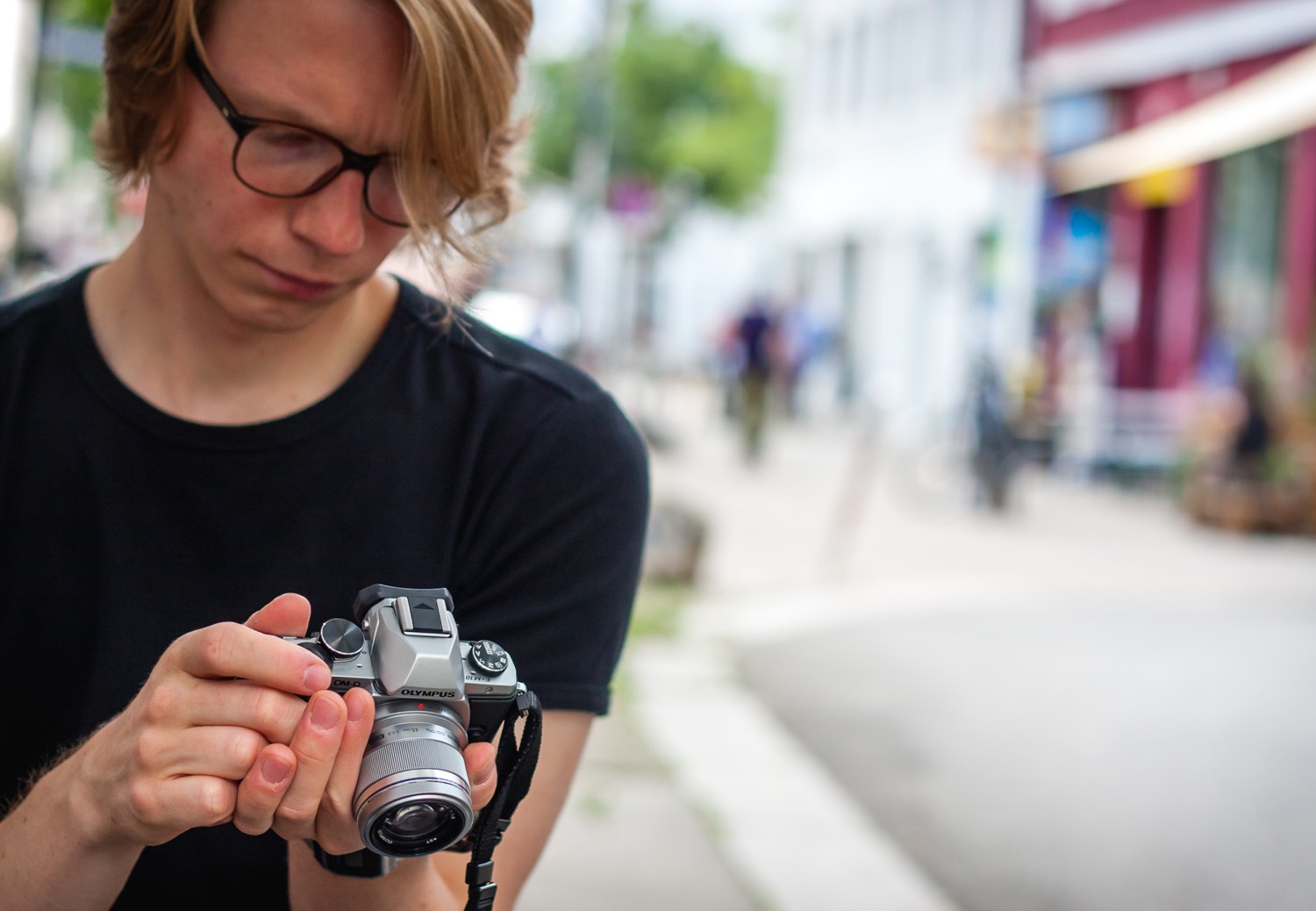
Olympus E-M10, with the Olympus 45mm f1.8 lens – and me, not knowing how to hold a camera – photo by Silvan Dähn
Closing thoughts
I hope this is a useful overview and example of what could be important to think about in a new camera. I’m only a few months in with my E-M10, but I’m exceedingly happy with it.
When I got the E-M10 Mark I, it was the best deal, no question. Now, it actually got a bit worse, and the Mark I and II are closer together now, within about 150€. If the small improvements sound interesting to you, maybe that’s worth it. Check out DPreview’s E-M10 Mark II review. A used E-M5 might also be an option, if you can stomach the lack of Wifi.
If you’ve made it this far, you must be really interested. If you’re already looking for lenses, the Wirecutter has a good piece, worth a read.
September 28, 2015 | photography

a portrait – © Timm Schoof
I’ve always struggled with photography. After a trip to London at the age of 15, I realized that I had taken the worst pictures ever, and was really disappointed. So naturally, that was it for me and photography – at least for the next few years. Then, the iPhones came but I never quite got beyond taking snapshots. I also was just disappointed when they didn’t work. Or didn’t in Instagram’s square format – which, admittedly, is a bit less of a problem now, because the squares are gone now (the joy, the joy!).
Don’t we all take photos?
But, haven’t I been a “photographer” anyway? Aren’t we all, nowadays?
Well, yes and no. I watched photography from a distance. A few times I had fooled myself into thinking that I’d learn about exposure, aperture and all that complicated stuff just from an old book I had found in my father’s collection. My best guess is that I opened it once, saw a formula, and never opened it again. I never got to know basics like the triangle of aperture, shutter speed and ISO. Or optics in general: What is the focal length, what is the aperture?
Being a technical person, I still knew what a DSLR was – but not much more, nothing that brought me closer to the very matter of photography. With only a smartphone, I realize now, I had no “way in”.
A few months ago, I finally accepted a friend’s offer to borrow his DSLR, and everything changed. Turns out, dialing in all the settings individually really opens up the process/mystery of how a photo comes together.
Old Cameras are like Guitars
But let me back up a bit. I found that photography as a hobby is a bit like learning to play the guitar. You might not have a close friend who is a famous rockstar, but you probably have a few friends or relatives who at least at some point have played the guitar – and still have one sitting in their basement.
Same with photography: I bet you know someone who has a camera just lying around. And I’m not even only talking about an old point-and-shoot, but a consumer-level DSLR, like the Canon X00D (“Rebel” outside the EU) or the Nikon DXX00 models. Any of those, and probably a lot of other cameras out there are totally sufficient to find out whether or not photography is a thing you’re interested in just by playing with them. You won’t break anything, can learn everything there is to know, see which parameter has what effect in the end result.
Why your Smartphone still isn’t “good enough”
To circle back to the smartphone question: Yes, the cameras in smartphones nowadays are actually black-magic awesome, especially considering their size. Over the last few years, every time I was beginning to realize I’m interested in taking pictures, visual arts etc., that fact popped into my mind. And I stopped there, just short of seriously considering what would happen if I took a more serious camera in my hand, and tried to understand it.
Yes, I know that there are very, very talented photographers out there who take marvellous pictures with their iPhones. Some of them have never used anything but an iPhone, but many use and have used all kinds of cameras before – for several decades, even.
The thing is, though, that the iPhone has a special camera (a very special camera for very general purposes, one could say). Learning, or getting better at photography with it is a bit like learning how to drive in city traffic using the Mars rover. There are fashion shoots done entirely on an iPhone, but they’re still stunts.
For me, it’s not so much about the picture quality as it is about the accessibility of the mechanics that I mentioned above. The better image quality and options in lenses dedicated camers offer is, for the learning aspect, just added benefit.
So, still could be the iPhone is all you need, but it’s more likely that it doesn’t make photography as approachable to you as a dedicated camera would.
Let’s hear Chris Plante on this:
For most, the markedly improved cameras in our cell phones are enough. But I do suspect there are people like me who unwittingly forgot the pleasure of good photography because their phone made things easier and it captured images well enough.
His point and mine, I guess, are kind of aligned in that we’re both saying: The in-between state of smartphone photography is nice and all, but it might really pay off for you to dive in deeper.
All of this goes to say: If you sense that you have a thing for visual works, go for it. You might be frustrated with some pictures out of your iPhone really working and some really not, and I have good news for you: It doesn’t have to be that way.

Just try it.
That’s enough for a motivational speech, let’s get a little more hands-on.
If you know somebody who knows how to shoot a camera in manual mode, just buy them a beer or guilt them into explaining the basic controls to you. For me, it started to click a short time after I had taken two photos of a lamp post next to me, one with a large and one with a very small aperture. From there, I was motivated enough and internalized “the triangle” in no time.
If you can, try out aperture priority mode. It’s called A, Av or something like that on your camera’s mode dial. The aperture has the biggest stylistic impact on your picture most of the time, therefore it makes sense to adjust it manually and let the camera figure out the rest, which then is ISO and shutter speed. You worry about those later and only appreciate the effect aperture has on the picture. Not convinced? Try to be convinced by this video!
Online Resources against Roadblocks
If there are no manual-mode masters in your life, or if you want to dive in deeper: The internet has got you covered! I mean: I do like to figure stuff out by myself. I consider looking at a manual a failure, either for me or (more likely) for the manufacturer.
On the other hand, I do google stuff like any sane person nowadays should. Somewhere between those extremes, there are (YouTube) tutorials. I fully acknowledge that I am the last person to say this, but YouTube is awesome! There are also great for-pay tutorials on sites like lynda.com where you don’t have to pick the good tutorials out of the sea of the not-so-great ones. With a little effort though, you can find something that really kickstarts almost anything you’re not so skilled at yet on YouTube.
Anyway, I feel like for photography, there are very bad tutorials, especially the more general ones. So I’m just gonna throw a bunch of links in here :)
In this episode of the excellent What’s Tech podcast, Chris Plante (yes, from the article mentioned above) and Sean O’Kane explain what DSLRs, mirrorless cameras, ISO, shutter speed, and RAW are – recommended.
Videos
With all of the above, don’t mind the theme music, and/or dad jokes.
Cameras or Whatever
I also really enjoy the Cameras or Whatever podcast. They say it’s a “podcast for the working photographer”, but I didn’t find that to be a barrier for me as a beginner. I started with these episodes because they hit topics that were also wandering around my head. This order should be roughly equivalent to the relevance to beginners I think:

Focal length
An extra word on focal length: One could think it’s as easy as googling the definition… but it is not. All the graphics and examples like “greater focal length brings you closer” really didn’t do it for me, until I saw one specific graphic that I can’t find anymore. 🎉
Everything that focal lenght was to me were random numbers. Missing was a reference. But there is one, and it is our, the “regular” human field of view. Of course we have very wide peripheral vision, but the FOV people with glasses have for example, the “main” part of the vision is roughly equivalent to a 40-50mm focal length. Therefore lenses in that range are called “standard” lenses.
I find this diagram by Panasonic to be okay-ish. It comes close to the one I am not able to find.
Also handy, because you can play with the different examples and it also incorporates the focal length’s effect on the perspective is this site by Sony – I think you can see the compression effect pretty well in the example with the fountain.
There’s more
Of course it can always get more complicated, if you want it to. I only really learned about mirrorless cameras when I thought that I had settled on getting a used prosumer/enthusiast DSLR for myself. I now own a mirrorless camera. But that’s another post, probably the next one in this (two-part) series! Here it is: Choosing a Camera in 2015
Update: I stumbled across Shawn Blanc’s post about how the iPhone made him want more out of his photography (and which camera to pick for that). Interesting to see his angle on this topic.
June 14, 2015 | podcasts
Just a few quick thoughts and notes, all podcast-related
ungeheuerlich eschoofierend
So, unfortunately, shortly after my last post on the topic, my podcast ungeheuerlich eschoofierend ended. This happens, apparently. While I am sad to let this project go, I am also proud. We started out recording with an iPhone, then got a digital recorder, and finally two Shure SM58s for it. Then I learned how to use Logic Pro X, at least a little, and I think we had a very nice sounding podcast. And we got better with identifying and talking about topics, I think.
In the last episode, we even did an interview with Johanna, a feminist outside our immediate peer group, and had an exchange that really came out very nice (you really should check out this episode: ungeheuerlich eschoofierend 028: Sexismus – zu Gast: Johanna Polle).
Currently I’m thinking about ideas for a new podacst project. Something law-related one or the other way may come out of it, but I don’t know yet. If you have an idea, let me know!
Anyway, the first Podcaster Meetup in Hamburg happened, and I think that’s one of the ways the community can continue (or: start, for the cyncics out there) to develop this unique and awesome medium. If you are even only slightly interested in Podcasts and live in or around Hamburg, I urge you to keep an eye on the meetup group.
And for non-meatspace meetups, there is Sendegate, a forum-like place for discussions for the German podcast community. When I first came across Sendegate, it seemed only to be concerned with Podlove-related stuff, but it turns out that’s not true. Same here: If you’re interested at all, give it a try!
A Recommendation
After the accidental tech podcast had a discussion about women in tech, they did a host-switch with Rocket. Rocket is an awesome tech podcast hosted by Brainna Wu, Christina Warren and Simone De Rochefort. I had listened to the first episode of Rocket and wasn’t a fan. But by now they’ve really found their voice and I really, really like it. They’re funny, witty and on top of their game in their respective fields. Thumbs up!
Rocket











